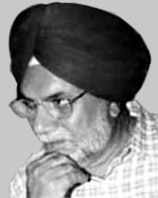 Ajmer Singh Aulakh dedicated his life to Theatre and his works mostly depicts the situations, issues and problems of a common man. He was born in the year of 1942. He was a playwright adept at subjecting local and folkloric tales to socio-historical meanings in the Punjabi theatre. His maiden collection of one-act drama, Arbad narbad dhundukara i.e. `Eons and Nebulae` in 1978, provides a case in point. The title piece has five characters drawn from romantic legends. Their tragic ends, popularly attributed to metaphysical dispensation, are read in historical terms. Engaging and spicy dialogue couched in colloquial idiom made these plays click with rural youth.
Ajmer Singh Aulakh dedicated his life to Theatre and his works mostly depicts the situations, issues and problems of a common man. He was born in the year of 1942. He was a playwright adept at subjecting local and folkloric tales to socio-historical meanings in the Punjabi theatre. His maiden collection of one-act drama, Arbad narbad dhundukara i.e. `Eons and Nebulae` in 1978, provides a case in point. The title piece has five characters drawn from romantic legends. Their tragic ends, popularly attributed to metaphysical dispensation, are read in historical terms. Engaging and spicy dialogue couched in colloquial idiom made these plays click with rural youth.
Ajmer Singh Aulakh experienced real fame with plays in miniature like Begane bohar di chhan i.e. `Shade of the Alien Oak` in 1981. This play depicts the miserable plight of a tenant farmer nagged all the time by members of his joint family. His desperation knows no bounds when, egged on by his wife, his younger brother demands a share of the land already unviable for a livelihood. A good-for-nothing villager offers a choric running commentary in black humour. In Ik Ramayan hor i.e. `One More Ramayana` in 1981, Aulakh argues unambiguously against interminable division of landholdings, through the process of transferring the mythical situation of Rama, his wife Sita, and brother Lakshman. It does not matter if, to ward off the eventuality, the wife has to bestow favours on her brother-in-law.
The next anthology, Anhe nishanchi i.e. `Blind Shooters` in 1983 presents violence as the last political weapon in the hands of the desperate and deprived peasantry. The adaptation Bhajian bahin i.e. `Broken Arms` in 1988 draws upon the terrorism, which, in that decade, played havoc with life in Punjab`s countryside. The full-length Kehar Singh di maut i.e. `Kehar Singh`s Death` in 1992, Aulakh`s original encounter with this theme, is not as gripping because he is essentially a master of the play-in-miniature.




















